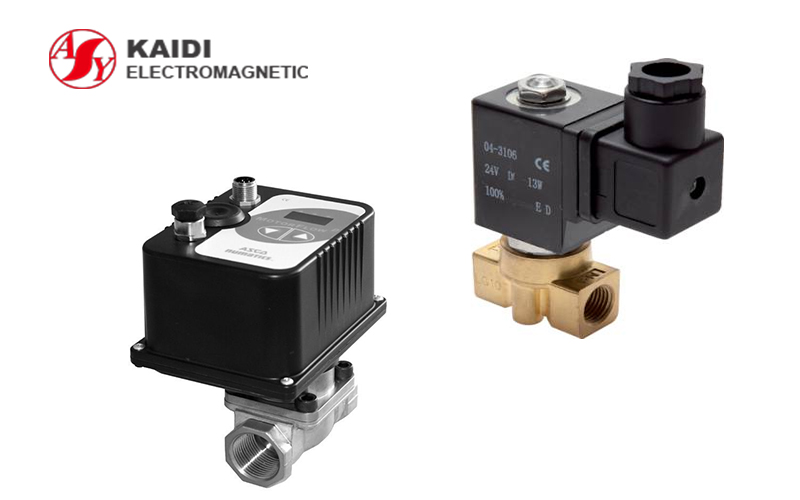According to researches, we find that installing a three-way pressure compensation valve and an overflow valve on the proportional reversing valve can not only greatly improve its response frequency, making the hydraulic system has a strong ability to resist load changes, but also reduce the energy loss of the hydraulic system during flow regulation, making it a kind of energy-saving proportional solenoid valve. So next, we will talk about this energy-saving valve in details.
The Main Structure of the Proportional Solenoid Valve
As shown in the following figure, the energy-saving proportional solenoid valve mainly consists of proportional reversing valve 1, pressure compensation valve 2, overflow valve 3 and the valve body 4. After the pressure oil enters the valve body 4 through the oil inlet P, it can selectively enter 3 different loops: one can reach the return port T through the pressure compensation valve 2. Another one can reach the oil inlet of the proportional reversing valve. The third one is connected to the pressure gauge. Among them, the control oil port of the pressure compensation valve 2 is connected with the oil outlet port A, and the oil outlet port A is also connected with the inlet port of the overflow valve 3. Finally, the oil outlet port of the overflow valve 3 will be connected with the oil outlet T.

Energy-saving Proportional Solenoid Valve Hydraulic Circuit
The energy-saving proportional solenoid valve and hydraulic system are connected as follows: the hydraulic pump is connected with the oil inlet P, the oil return port T is connected with the oil return port of the hydraulic oil tank, and the port A is connected with the execute component.

The Shape of Energy-saving Proportional Solenoid Valve
Operation Processes
When the solenoid of the proportional reversing valve 1 is not energized, the pressure oil will flow back to the hydraulic oil tank through the pressure compensation valve 2 and the return oil port T of the valve body 4. The set pressure of the pressure compensation valve 2 is only 1MPa. At this point, the hydraulic pump is almost in the unloading state with the lowest energy loss. Nevertheless, When the solenoid of the proportional reversing valve 1 is energized, the port P will be connected to port A, the oil circuit of the pressure compensation valve 2 will in a state of disconnection, and the pressure oil will enter the execute component through the proportional reversing valve 1.
When the load pressure fluctuates, the upstream pressure of the proportional reversing valve 1 always changes with the load pressure under the regulation of the pressure compensation valve 2, making the proportional reversing valve 1 maintains a constant operating differential pressure and a stable load flow, so that the system has a better ability to resist the load change.
When the execute component is stuck and the system pressure increases instantaneously, the overflow valve 3 will play its role. The pressure oil will flow back to the hydraulic oil tank through the overflow valve 3 to protect the hydraulic component from the damage of the high pressure.
Three Advantages of Adopting this Energy-saving Proportional Solenoid Valve
- The high accuracy of flow regulation: this proportional solenoid valve adjusts the position of the valve core through changing the input current so as to regulate the flow rate of oil and change the operating speed of the execute component. Since the electric proportional device of the proportional solenoid valve adopts PWM (pulse width modulation) to transmit information, it requires a higher accuracy of flow regulation.
- The high response frequency and the strong resistance to load variations: the pressure compensation valve installed on the proportional solenoid valve can stabilize the load flow by stabilizing the front and rear pressure difference of the solenoid valve, so that it can enhance the system’s resistance to load change. If we install this proportional solenoid valve on the quantitative pump system, the speed regulating mechanism of the quantitative pump system will have higher response frequency. However, if we install this proportional solenoid valve on the variable pump system, the response frequency of the speed regulating mechanism will depend on the response frequency of the variable pump.
- Good energy saving performance: when the execute component does not work, the pressure oil of the hydraulic pump will flow back to the oil tank through the pressure compensation valve, and the energy loss will reach the minimum.
Kaidi is a solenoid coil supplier from China, we provide various kind of solenoid and solenoid coils, such as Rexroth solenoid coil, Yuken solenoid coil, Vickers solenoid coil, Parker solenoid coil and other custom solenoid or solenoid coil according to your drawing or samples. If you are interested in our products, please feel free to contact us.
